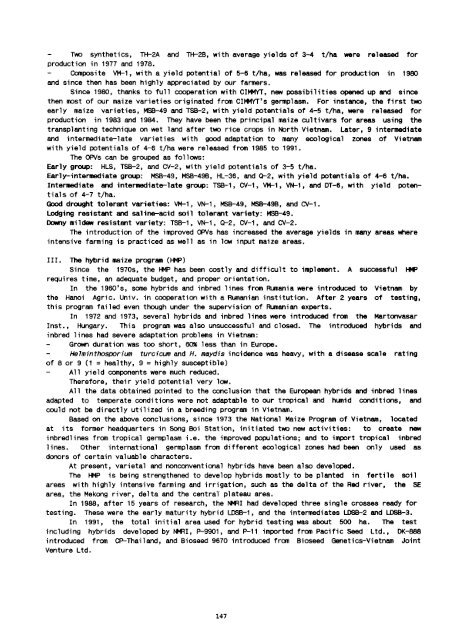Proceedings of the Fifth Asian Regional Maize Workshop - Search ...
Proceedings of the Fifth Asian Regional Maize Workshop - Search ...
Proceedings of the Fifth Asian Regional Maize Workshop - Search ...
Create successful ePaper yourself
Turn your PDF publications into a flip-book with our unique Google optimized e-Paper software.
Two syn<strong>the</strong>tics, TH-2A and TH-2B, with average yields <strong>of</strong> 3-4 t/ha were released for<br />
production in 1977 and 1978.<br />
Composite VM-1, with a yield potential <strong>of</strong> 5-6 t/ha, was released for production in 1980<br />
and since <strong>the</strong>n has been highly appreciated by our farmers.<br />
Since 1980, thanks to full cooperation with CI~, new possibilities opened up and since<br />
<strong>the</strong>n most <strong>of</strong> our maize varieties originated from CI~'s germp1asm. For instance, <strong>the</strong> first two<br />
early maize varieties, MSB-49 and TSB-2, with yield potentials <strong>of</strong> 4-5 t/ha, were released for<br />
production in 1983 and 1984. They have been <strong>the</strong> principal maize cu1tivars for areas using <strong>the</strong><br />
transplanting technique on wet land after two rice crops in North Vietn8lll. Later, 9 intermediate<br />
and intermediate-late varieties with good adaptation to many ecological zones <strong>of</strong> Vietn8lll<br />
with yield potentials <strong>of</strong> 4-6 t/ha were released from 1985 to 1991.<br />
The OPI/s can be grouped as follows:<br />
Early group: HLS, TSB-2, and CV-2, with yield potentials <strong>of</strong> 3-5 t/ha.<br />
Early-intermediate group: MSB-49 , MSB-49B, HL-36 , and Gr-2, with yield potentials <strong>of</strong> 4-6 t/ha.<br />
Intermediate and intermediate-late group: TSB-1, CV-1, VM-1, VN-1, and DT-6, with yield potentials<br />
<strong>of</strong> 4-7 t/ha.<br />
Good drought tolerant varieties: VM-1, VN-1, MSB-49 , MSB-49B, and CV-1.<br />
Lodging resistant and saline-acid soil tolerant variety: MSB-49.<br />
Downy mildew resistant variety: TSB-1, VN-1, Gr-2, CV-1, and CV-2.<br />
The introduction <strong>of</strong> <strong>the</strong> improved OPI/s has increased <strong>the</strong> average yields in many areas where<br />
intensive farming is practiced as well as in low input maize areas.<br />
III.<br />
The hybrid maize program (I+1P)<br />
Since <strong>the</strong> 1970s, <strong>the</strong> I+1P has been costly and difficult to implement. A successful HMP<br />
requires time, an adequate budget, and proper orientation.<br />
In <strong>the</strong> 1960's, some hybrids and inbred lines from Rumania were introduced to Vietn8111 by<br />
<strong>the</strong> Hanoi Agric. Univ. in cooperation with a Rumanian institution. After 2 years <strong>of</strong> testing,<br />
this program failed even though under <strong>the</strong> supervision <strong>of</strong> Rumanian experts.<br />
In 1972 and 1973, several hybrids and inbred lines were introduced from <strong>the</strong> Martonvasar<br />
Inst., Hungary. This program was also unsuccessful and closed. The introduced hybrids and<br />
inbred lines had severe adaptation problems in Vietnam:<br />
Grown duration was too short, ~ less than in Europe.<br />
He1minthosporium turcicum and H. maydis incidence was heavy, with a disease scale rating<br />
<strong>of</strong> 8 or 9 (1 = healthy, 9 = highly susceptible)<br />
All yield components were much reduced.<br />
Therefore, <strong>the</strong>ir yield potential very low.<br />
All <strong>the</strong> data obtained pointed to <strong>the</strong> conclusion that <strong>the</strong> European hybrids and inbred lines<br />
adapted to temperate conditions were not adaptable to our tropical and humid conditions, and<br />
could not be directly utilized in a breeding program in Vietnam.<br />
Based on <strong>the</strong> above conclusions, since 1973 <strong>the</strong> National <strong>Maize</strong> Program <strong>of</strong> Vietnam, located<br />
at its former headquarters in Song 80i Station, initiated two new activities: to create new<br />
inbred1ines from tropical germplasm i.e. <strong>the</strong> improved populations; and to import tropical inbred<br />
lines. O<strong>the</strong>r international germplasm from different ecological zones had been only used as<br />
donors <strong>of</strong> certain valuable characters.<br />
At present, varietal and nonconventional hybrids have been also developed.<br />
The I+1P is being streng<strong>the</strong>ned to develop hybrids mostly to be planted in fertile soil<br />
areas with highly intensive farming and irrigation, such as <strong>the</strong> delta <strong>of</strong> <strong>the</strong> Red river, <strong>the</strong> SE<br />
area, <strong>the</strong> Mekong river, delta and <strong>the</strong> central plateau area.<br />
In 1988, after 15 years <strong>of</strong> research, <strong>the</strong> NMRI had developed three single crosses ready for<br />
testing. These were <strong>the</strong> early maturity hybrid LDSB-1, and <strong>the</strong> intermediates LDSB-2 and LDSB-3.<br />
In 1991, <strong>the</strong> total initial area used for hybrid testing was about 500 ha. The test<br />
including hybrids developed by NMRI, P-9901, and P-11 imported from Pacific seed Ltd., DK-888<br />
introduced from CP-Thai1and, and Bioseed 9670 introduced from Bioseed Genetics-Vietnam Joint<br />
Venture Ltd.<br />
147

















